|
The material on this website is intended for educational use only and may not be reproduced for commercial purposes without express permission from the appropriate copyright holder.
Le contenu de ce site Web est destiné à des fins pédagogiques seulement et ne peut être reproduit à des fins commerciales à moins d'en avoir obtenu la permission du titulaire du droit d'auteur approprié.
"The Unanimous Voice of the Continent is Canada must be ours! Quebec must be taken."
John Adams
"Quebec remained British because it was French."
George M. Wrong, Canada and the American Revolution , 1935
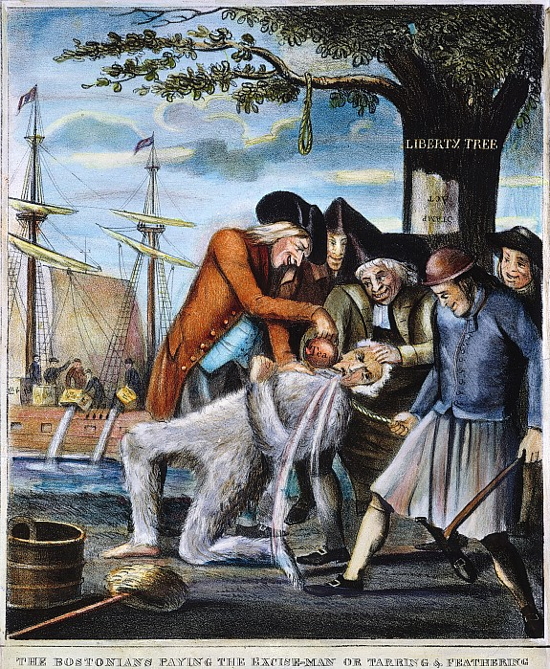
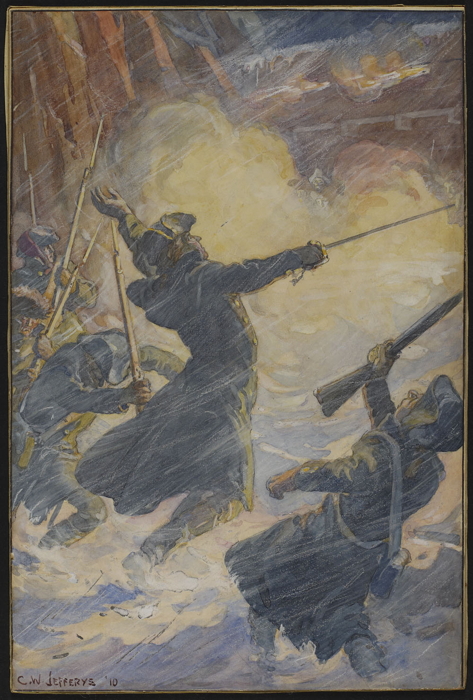
Death of Montgomery at Quebec, 31 December 1775. LAC Acc. No. 1972-26-763,
Charles William Jefferys, 1920s or 1930s?

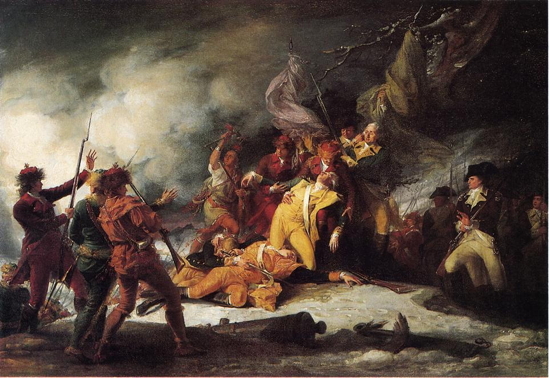
Death of Montgomery, 31 December 1775, Artist John Turnbull, 1 January 1806
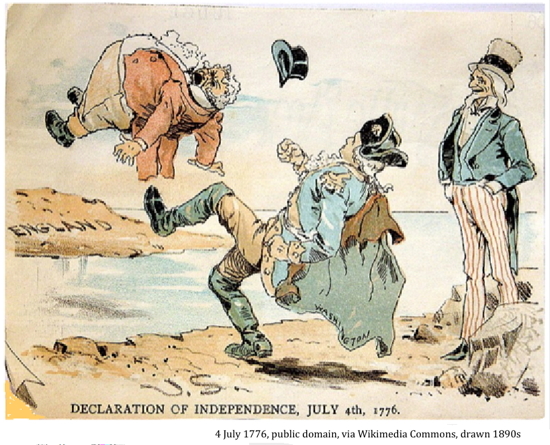
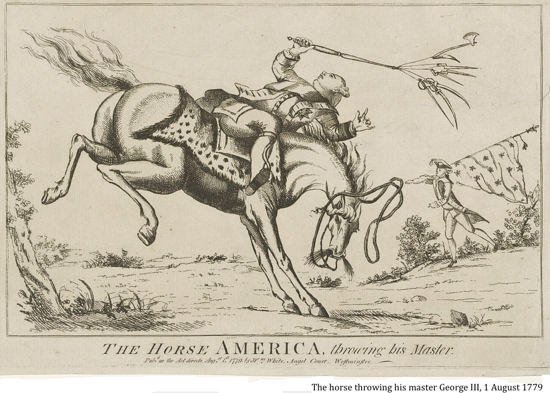
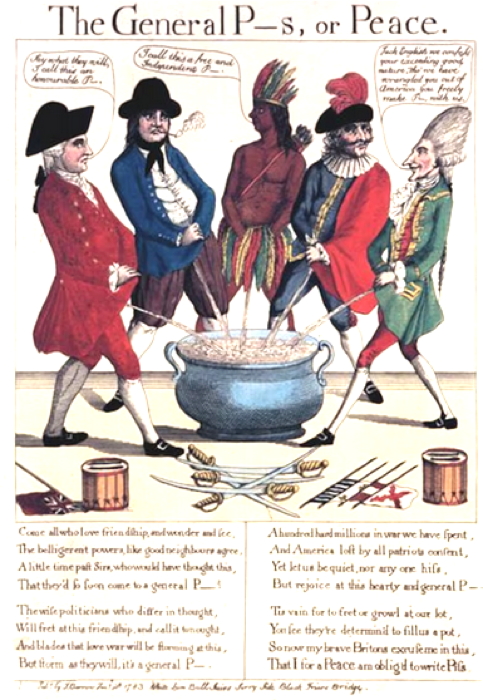
Treaty of Paris 1783
Print shows five men, an Englishman, a Dutchman, a Native representing America, a Spaniard, and a Frenchman urinating into a pot. The Englishman says, "Say what they will, I call this an honourable P--," the Native says, "I call this a free and Independent
P--," and the Frenchman says, "Jack English we confess your exceeding good nature, tho' we have wrangled you out of America you freely make P-- with us." Five swords, two drums, and the flags of the respective nations rest on the ground before the pot.
Come all who love friendship, and wonder and see,
The belligerent powers, like good neighbours agree,
A little time past Sirs, who would have thought this,
That they’d so soon come to a general P––.
The wife politicians who differ in thought,
Will fret at this friendship, and call it to nought,
And blades that love war will be storming at this,
But storm as they will, it’s a general P–––.
A hundred hard millions in war have spent,
And America lost by all patriots consent,
Yet let us be quiet, not any one hiss,
But rejoice at this hearty and general P–––.
Tis vain for to fret or growl at our lot,
You see they’re determined to fill us a pot,
So now my brave Britons excuse me in this
That I for a Peace am obliged to write Piss.
"The Revolution, designed to create one nation, had created two."
Bruce Hutchison, 1955
"Historically, a Canadian is an American who rejects the Revolution."
Northrup Frye, 1952
"Canadians are the children of divorced parents and they know the bitterness that comes of a broken home."
A. R. M. Lower
"The outcasts of one land become the founders of another."
L. S. Upton
"America has her patriots. Canada has the loyalists."
Dalton Camp, Points of Departure, 1979
"In the American view Loyalists were unregenerate Tories, place-men, servile monarchists, enemies of the notion of liberty upon which the new republic was founded. In the Canadian view they became heroes who endured exile and hardship to demonstrate their attachment to the Crown and the British connection and their abhorrence of mob violence and democratic excesses."
Kenneth D. McRae
"The arduous and glorious task to which Providence had assigned them [the UEL] was to transplant in this new soil British law and British institutions, and to guard and transport to their successors the germ of a great idea – the solidarity of the British race and empire."
Coyne, Memorial to the United Empire Loyalists
"The words which appear most often in the loyalist rhetoric were order, stability, allegiance, service, law-abiding, authority, tradition, inheritance, continuity."
Carl Berger, The Sense of Power
"Loyalist blood – those are proud words still in Canada, nowhere more than in Nova Scotia."
Thomas H. Raddell

The coming of the Loyalists, 1783. L'arrivée des Loyalistes, 1783. LAC Acc. No. 1996-282-7, Henry Sandham, 1925

Black Settlers at Bedford Basin, NS, by Robert Petley, 1835, LAC 1938-220-1
[3500 black loyalists and 2000 slaves arrived in Nova Scotia after the American Revolution.]
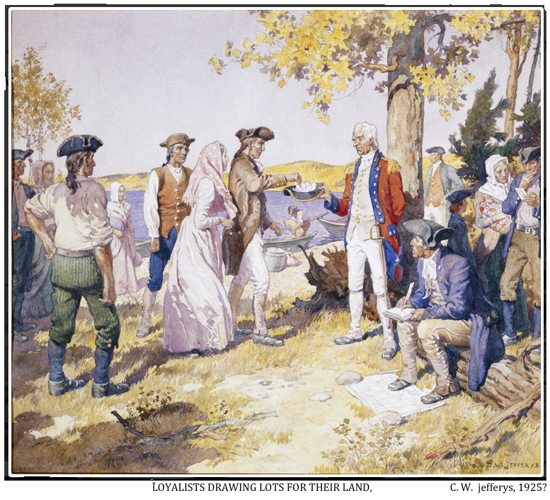
United Empire Loyalists Landing at the Site of the Present City of Saint John, New Brunswick, 1783. LAC Acc. No. 1939-61-1, John David Kelly, before 1935
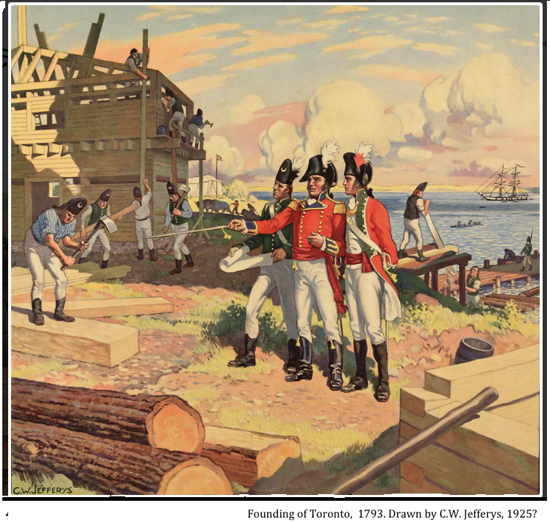
"Ut Incepit Fidelis, Sis Permanet (Loyal she began, loyal she remains)."
Official Motto of Ontario
"Many a Canadian can trace lineage back to a United Empire Loyalist woman who planted the first crop by hand with a hoe and reaped the first crop by hand with a sickle."
Agnes C. Laut
"[The United Empire Loyalists] were the very cream of the population of the Thirteen Colonies. They represented . . . the learning, the piety, the gentle birth, the wealth and good citizenship of the British race in America, as well as its devotion to law and order, British institutions, and the unity of the Empire."
James H. Coyne, Memorial to the United Empire Loyalists

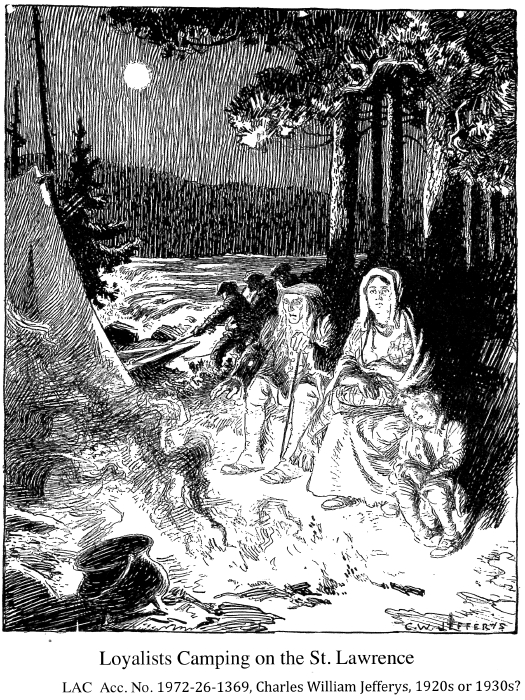
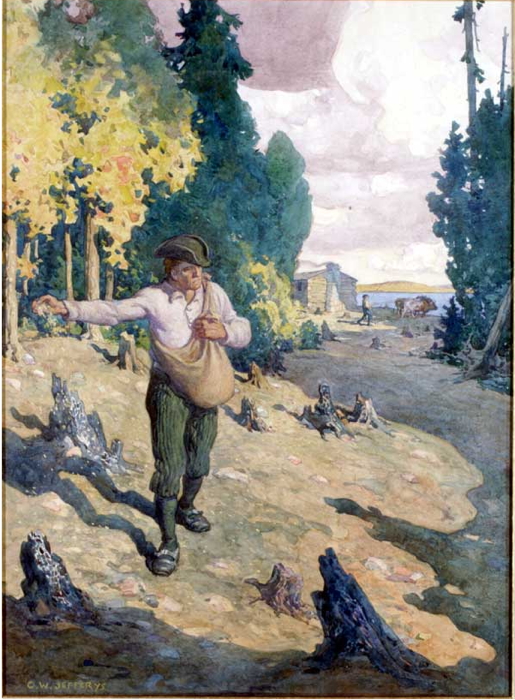
The Pioneer, by Charles William Jefferys, Archives of Ontario 623327
"Those noble men [UEL] and women who, rather than live under an alien rule, left all the comforts and luxuries of their well filled homes that they might found in the then wilderness of Canada a new home, where the British flag might still wave over, and the British still govern them."
R. N. Ball
"Who is a Canadian? Well, the political answer is that he is an American who avoided Revolution."
Northrop Frye, The Globe and Mail, 6 April 1976
"No country in the world ever received a higher class of immigrants."
Sir John George Bairinot
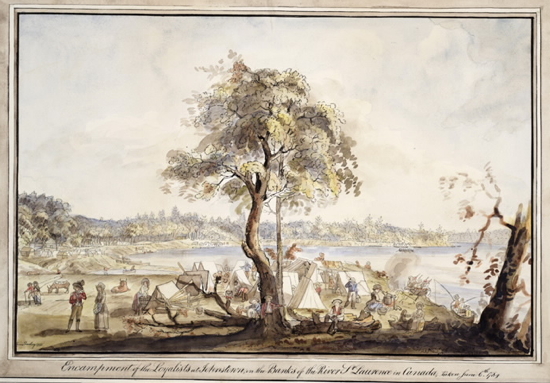
Encampment of the Loyalists at Johnstown [Cornwall]., by James Peachey, 6 June 1784, TRL JRR 2016 Cab III
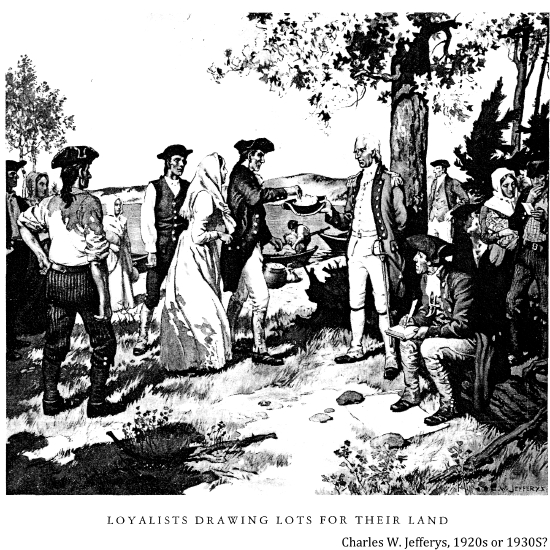
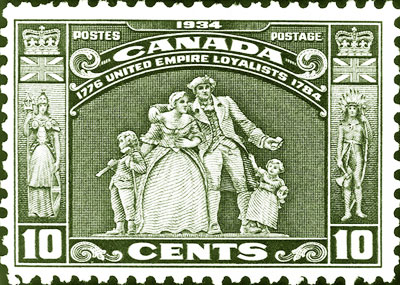
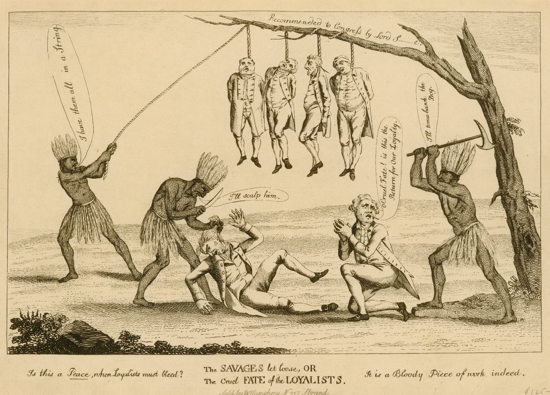
The savages let loose, or The Cruel fate of the Loyalists. Library of Congress, 97515386, London, William Humphrey, March 1783
The SAVAGES let loose, OR The Cruel FATE of the LOYALISTSIs this a Peace, when Loyalists must bleed? It is a Bloody Piece of work indeed.
[Left Indian] I have them all in a string.
[Top centre] Recommended to Congress by Lord S–––––––e.
[Centre Indian] I'll scalp him.
[Loyalist] O Cruel Fate! Is this the Return for Our Loyalty.
[Right Indian] I'll tomahawk the dog.

"The conclusion of the Revolution did not end the American fear of Canada as a British knife poised for a thrust against the northern states."
Donald F. Warner, 1960
"I verily believe that the militia of Kentucky are alone competent to place Montreal and Upper Canada at your feet."
Henry Clay, 1810
"The acquisition of Canada this year [1812], as far as the neigbourhood of Quebec, will be a mere matter of marching, and will give us experience for the attack of Halifax the next, and final expulsion of England from the American continent."
Thomas Jefferson, letter, 4 August 1812
"We can take Canada without soldiers. We have only to send officers into the Provinces, and the people, disaffected towards their own Government, will rally round our standard."
William Eustis, Secretary of War.
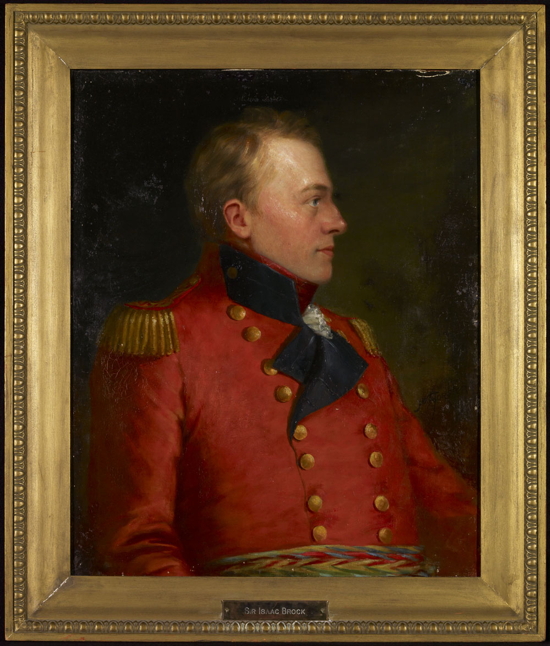
Sir Isaac Brock. LAC Acc. No. 1991-30-1, John Wycliffe Lowes Forster, 1920s?
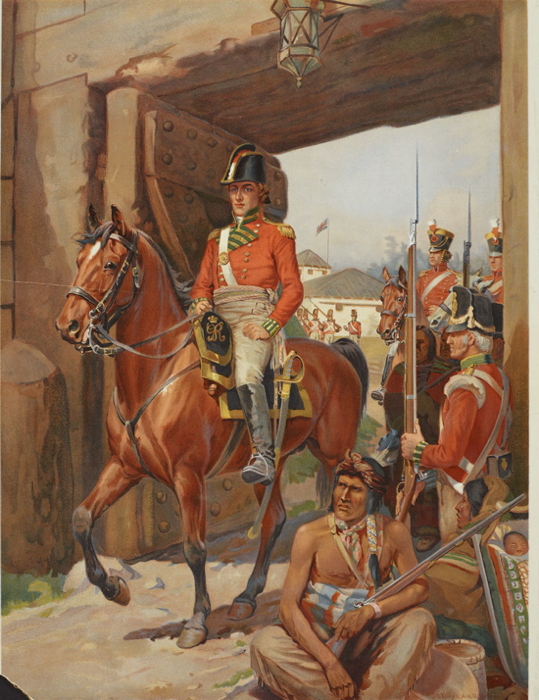
Brock Entering Queenston, 1812. Brock entrer à Queenston. LAC e01952223, Arthur H. Hider and John David Kelly, ca. 1906
"A country defended by Free Men, enthusiastically devoted to the cause of their King and Constitution, can never be conquered."
General Isaac Brock, 1812
"The Canadian people . . . look upon him [Sir Isaac Brock] as the Americans look upon Washington."
Charles Mair, Tecumseh. A Drama, 1886
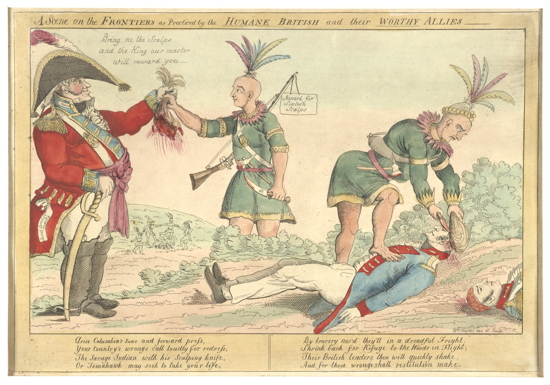
A scene on the frontiers as practiced by the "humane" British and their "worthy" allies, Library of Congress, William Charles, Philadelphia, 1812
[Charles denounces British and Indian depredations on the American frontier during the War of 1812, alluding specifically to the practice of offering bounties for American scalps. The cartoon may have been prompted by the August 1812 massacre at Chicago and the purchase of American scalps there by British Colonel Proctor. On the left a British officer receives a bloody scalp from an Indian, who has a purse with "Reward for Sixteen Scalps" hanging from his flintlock. The Indian's knife and tomahawk bear the initials "GR" (for Georgius Rex, i.e., King George). The officer says, "Bring me the Scalps and the King our master will reward you." From a button on the officer's coat hangs a tag or sack labeled "Secret Service Money." At right, another Indian is in the process of scalping a fallen soldier; another dead, scalped soldier lies nearby. In the background two Indians and two soldiers dance about a campfire. Below are eight lines of verse: "Arise Columbia's Sons and forward press, / Your Country's wrongs call loudly for redress; / The Savage Indian with his Scalping knife, / Or Tomahawk may seek to take your life; / By bravery aw'd they'll in a dreadful Fright, / Shrink back for Refuge to the Woods in Flight; / Their British leaders then will quickly shake, / And for those wrongs shall restitution make."]
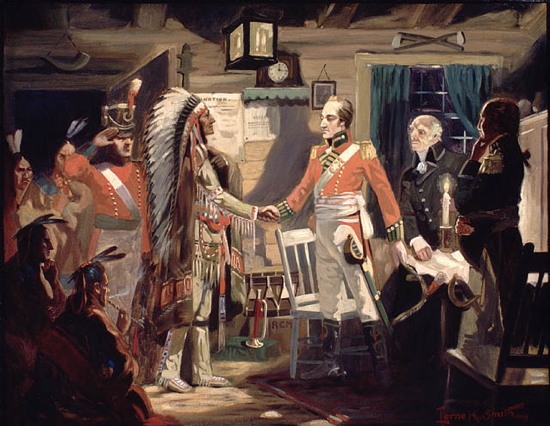
The Meeting of Brock and Tecumseh. LAC Acc. No. 1997-229-1, Lorne K. Smith, [between 1920-1930]

Meeting of Brock and Tecumseh, 1812. LAC Acc. No. 1972-26-1360, Charles William Jefferys, 1920s or 1930s?

"The army under my command has invaded your country. The standard of the Union now waves over the territory of Canada. To the peaceable, unoffending inhabitants it brings neither danger nor difficulty . . . The United States offers you peace, liberty, and security. . . I tender you the invaluable blessings of Civil, Political and Religious Liberty. . . You will be emancipated from Tyranny and Oppression and restored to the dignified station of Freemen."
General William Hull, 1812
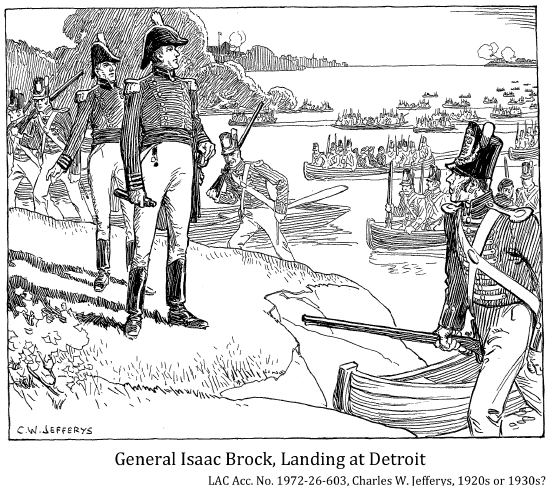

British Warfare in 1812, 1837-38, LAC Acc. No. 1970-188-2011 W.H. Coverdale Collection of Canadiana, Henry R. Robinson, New York, ca. 1843
[Inscribed in the print, [on image, in caption bubble with native] u.l.: Give me plenty / rum, Gubner / Head, I catch / you more / Scalps - ! ; [in caption bubble with Officer wearing busby] u.l.: No Quarter, no prisoners! / Hurrah! for Queen Victoria! ; [on sign in man's hand] c.: LIBERTY / to the / NEGROES. ; [in caption bubble with Black man wearing uncoloured military jacket] c.r.: Gorra [sic] - mighty! / me burn all de [sic] / farming untensil [sic]! ; [on burning ship] l.l.: CAROLINE / BUF [space] FA [....] ; [on sign at foot of Officer] l.: Rights / of Nations ; [on sign at foot of Officer] r.: Rights of War / between / Civilized Nations ; [below image] b.: BRITISH WARFARE IN 1812, 1837-38.]
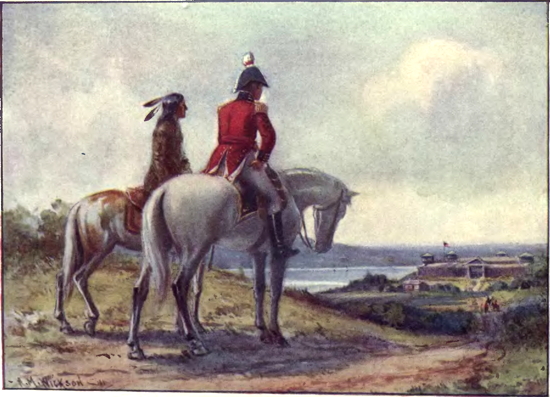
Tecumseh and Brock at Detroit, Alfred Morton Wickson, 14 August 1812, Public domain, via Wikimedia Commons

Surrender of Hull. LAC Acc. No. 1997-56-1, Henry Louis Stephens, ca.1833-1866
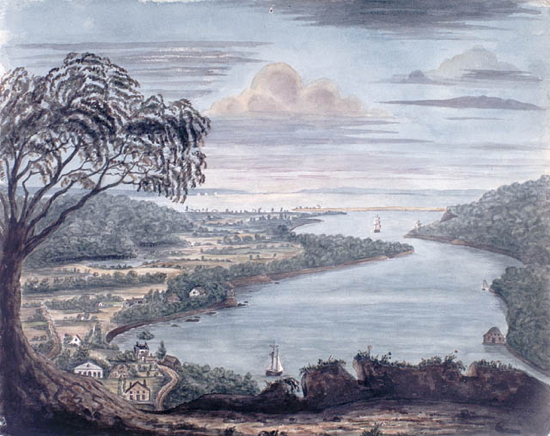
Vue de Queenston Heights, Haut-Canada (Queenston, Ont.). LAC Acc. No.
1989-494-10, Francis Hall, September 1816
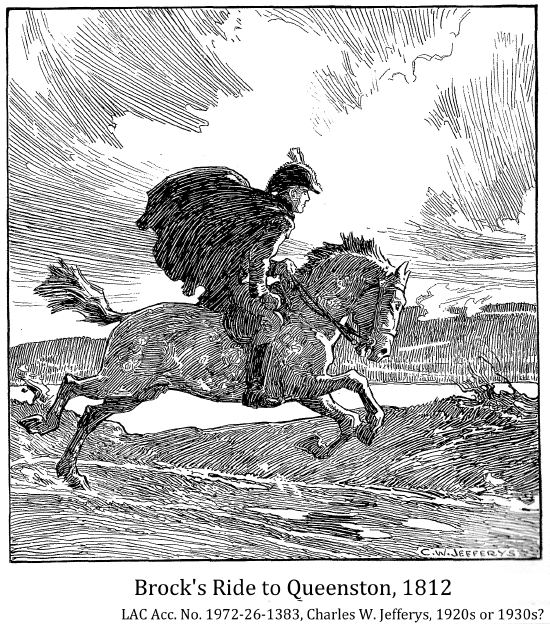
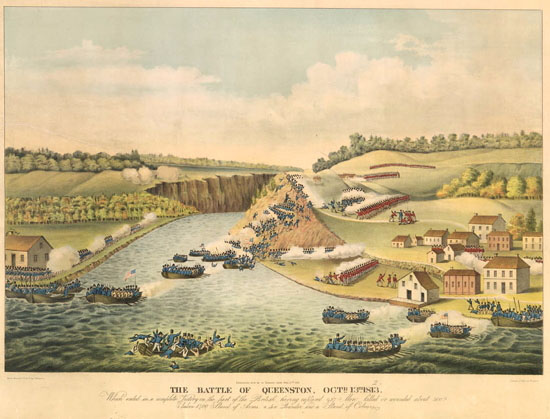
The Battle of Queenston, 13 October 1812. LAC Acc. No. R13133-387, James Dennis, 1836
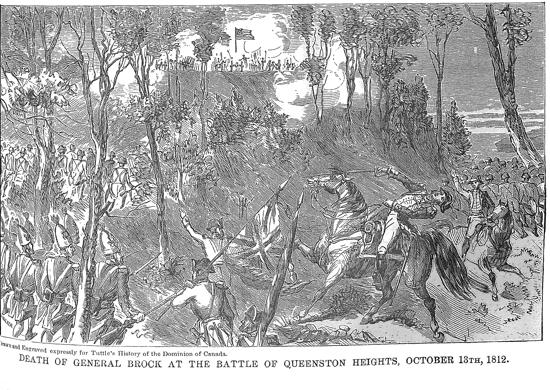
Short History of the Dominion of Canada, Charles R. Tuttle, 1878
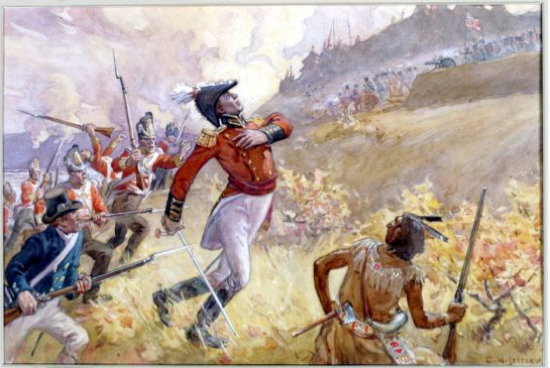
Death of Isaac Brock. LAC C-008261, Charles William Jefferys, 1920s or 1930s?
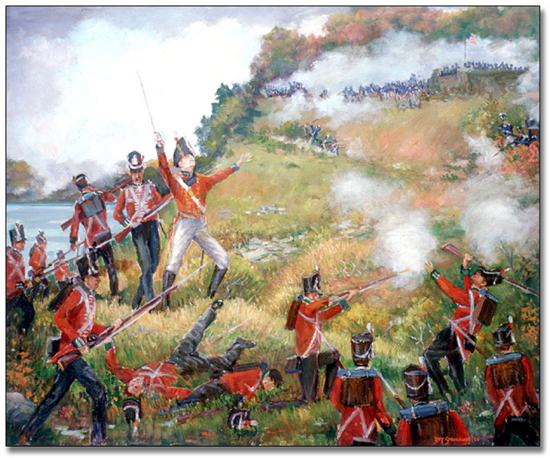
The Death of Brock at Queenston Height, by C. W. Jefferys, ca.1908, Archives of Ontario
"It is to that illustrious man [Sir Isaac Brock] of glorious memory that we owe the preservation of this country . . . and those British institutions which it is our happiness now to enjoy."
J. A. MacDonell, speaker at the unveiling of the Sir Isaac Brock monument,1912
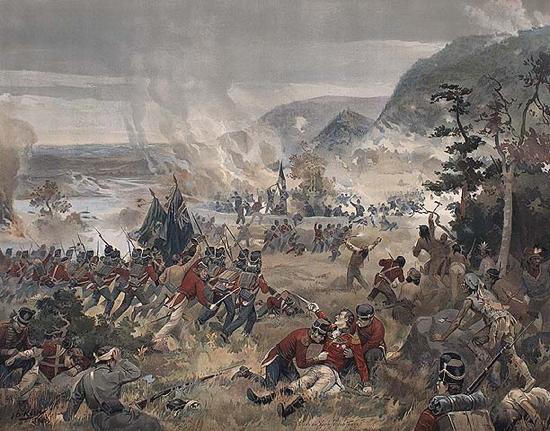
Battle of Queenston Heights, 13 October 1812. La bataille de Queenston Heights, 13 octobre 1812.. LAC Acc. No. 1954-153-1, John David Kelly, 1896
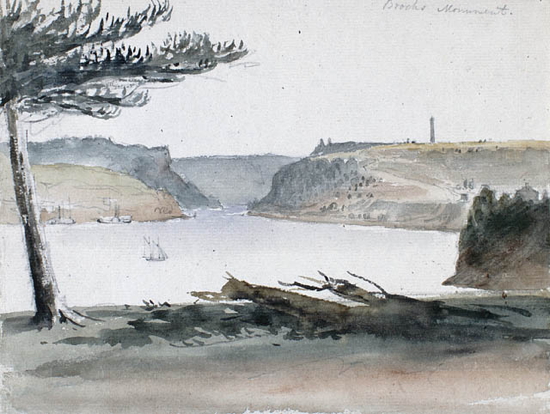
Brock's Monument, Queenston Heights. Monument de Brock, Queenston Heights. LAC Acc. No. 1983-47-40R, Philip John Bainbrigge, 1836-1842
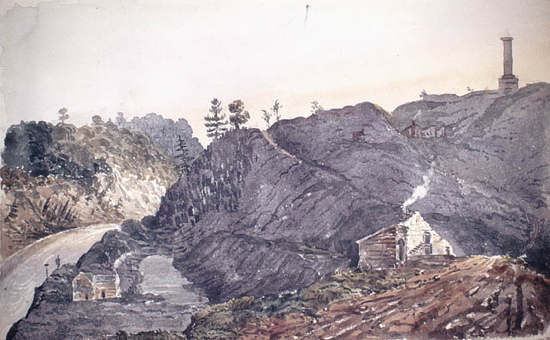
General Brock's Monument on the Heights at Queenston. Le monument du général Brock sur les collines de Queenston. LAC Acc. No. 1955-102-65, 2 April 1825
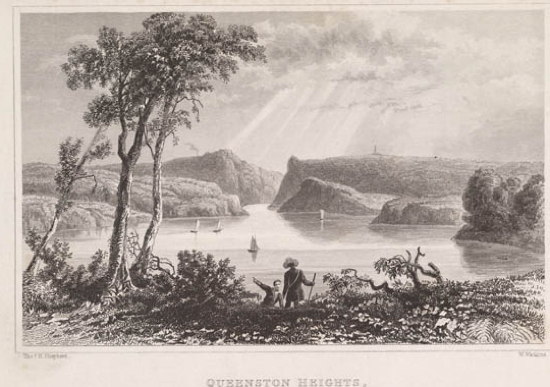
Queenston Heights. LAC Acc. No. R9266-1696, Thomas H. Shepherd, n.d.
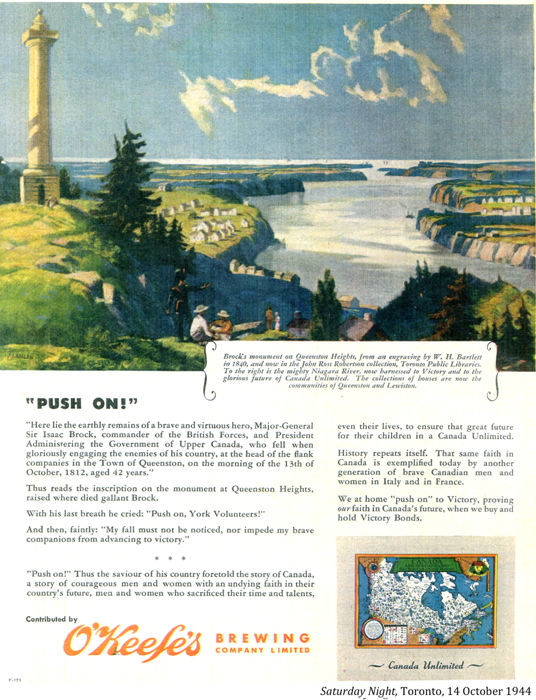

Death of Gen. Pike, At York, (U.C.) on the 27th April, 1813. La mort du Général Pike à York (Haut-Canada), le 27 avril 1813. LAC Acc. No. 1990-553-734 [Zebulon Montgomery Pike], n.d.
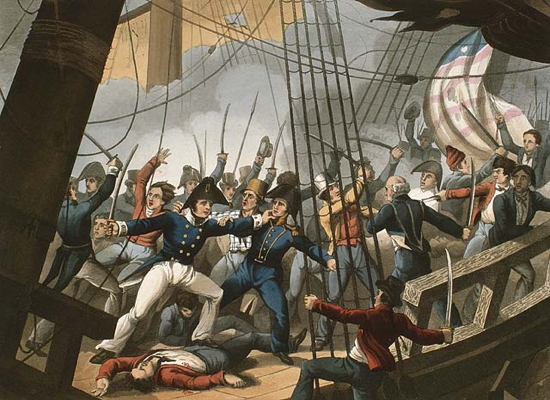
Boarding and taking the American Ship Chesapeake by the Officers and Crew of H.M. Ship Shannon commanded by Capt. Broke, June 1813 [Abordage et capture du navire américain Chesapeake par les officiers et l'équipage du HMS Shannon commandé par le capitaine Broke, juin 1813]. LAC Acc. No. 1937-31-1, Matthew Dubourg, 1816
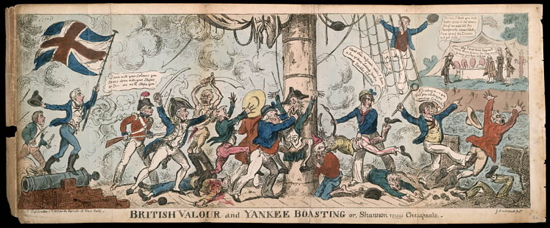
British Valour and Yankee Boasting or Shannon versus Chesapeake. Le courage britannique et la vanterdise américaine ou Shannon contre Chesapeake. LAC Acc. No. R9266-3418 Collection de Canadiana Peter Winkworth, George Cruickshank, 1813
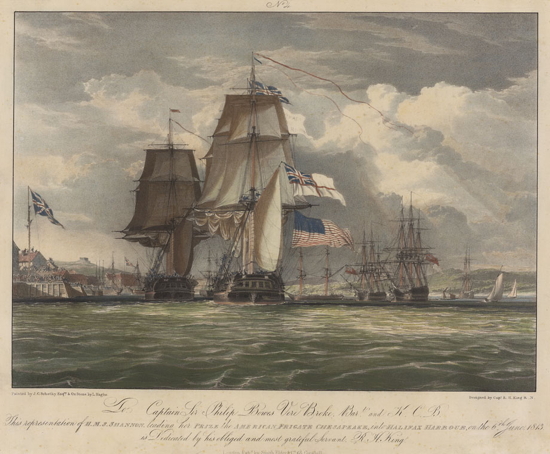
[No. 4] H.M.S. Shannon Leading Her Prize the American Frigate Chesapeake Into Halifax Harbour. [No. 4] H.M.S. Shannon menant la frégate américaine Le Chesapeake dans le port de Halifax. LAC 1970-188-1937 W.H. Coverdale Collection of Canadiana, John Christian Schetky, ca. 1830
Battle-ground of Stony (sic) Creek. LAC C-005320, 1894
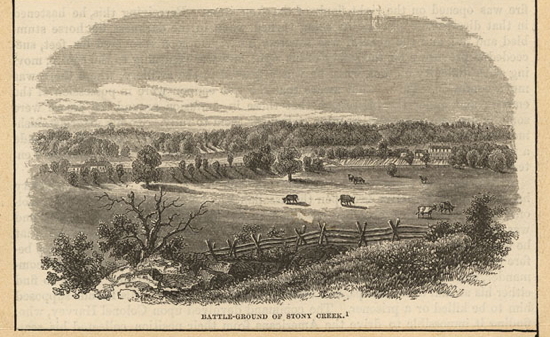
Battle at Stoney Creek, 1813. LAC Acc. No. 1972-26-596, Charles William Jefferys, 1920s or 1930s?
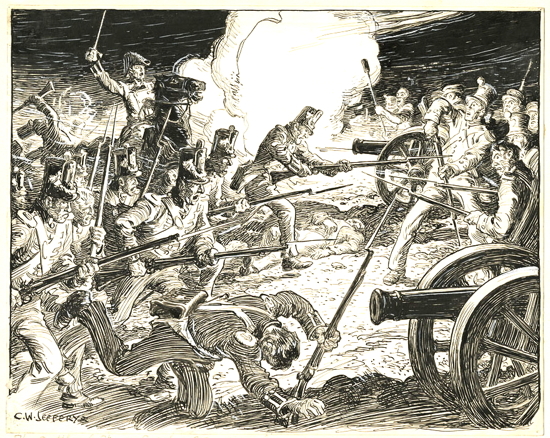
Battle at Stoney Creek, 1813. LAC Acc. No. 1972-26-596, Charles William Jefferys, 1920s or 1930s?
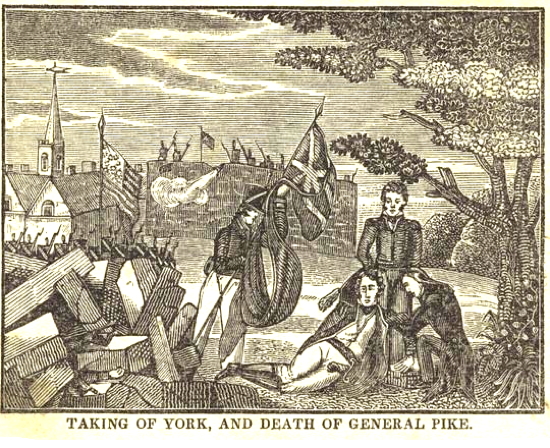
Taking of York, 1813, New York Public Library, b1716862, 1844
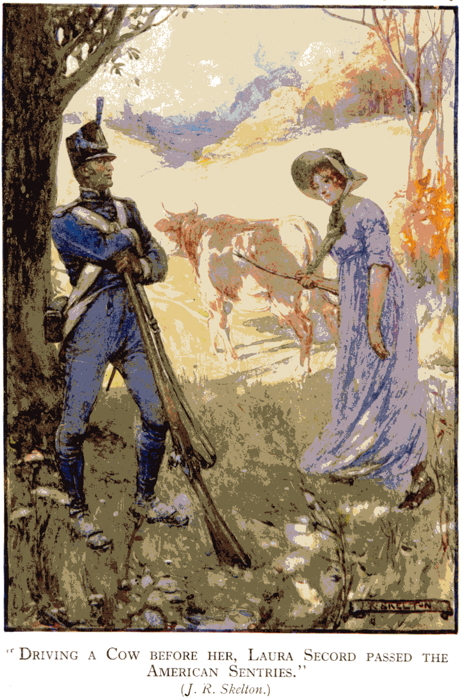
Laura Secord. LAC 1996-282-10, Henry Sandham, ca. 1910
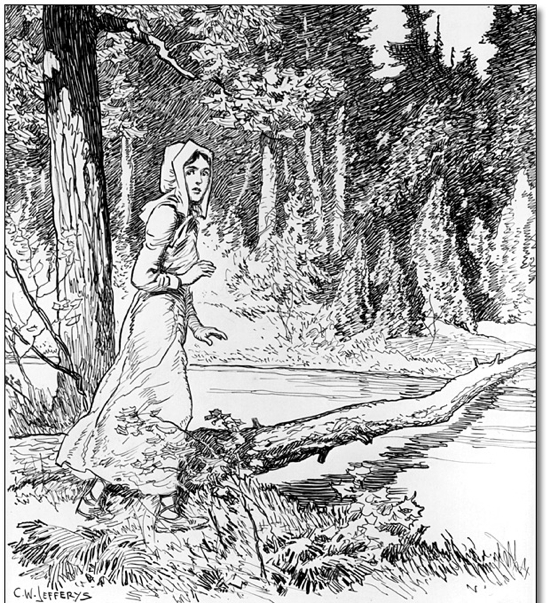
Laura Secord on Her Way to Warn the British, 1813. LAC Acc. No. 1972-26-1405, Charles William Jefferys, 1920s or 1930s?

Laura Secord, Legendary Patriot [graphic material] = Laura Secord, Héroïne légendaire. LAC R169-2562-1-E, 1992, Canada Post Corporation
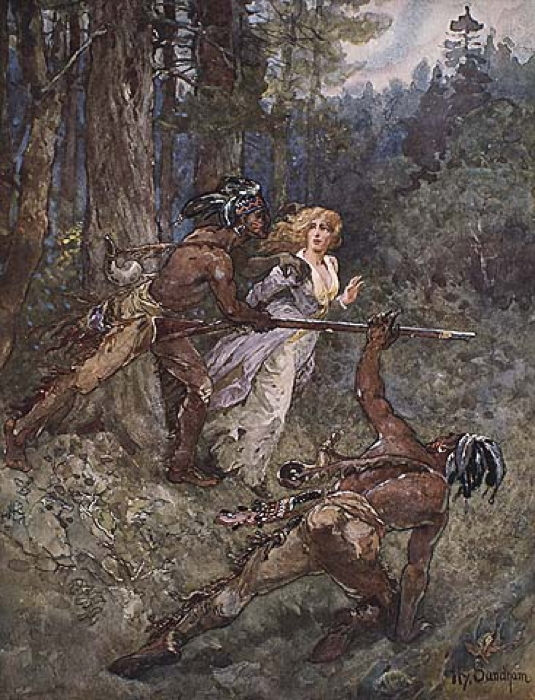
Laura Secord. LAC 1996-282-10, Henry Sandham, ca. 1910
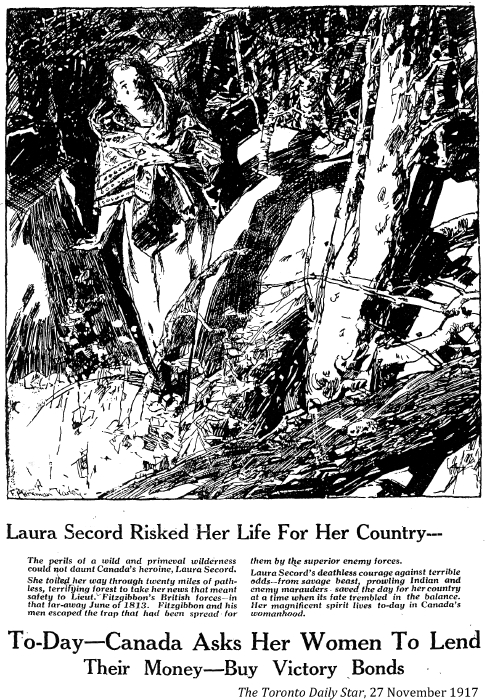
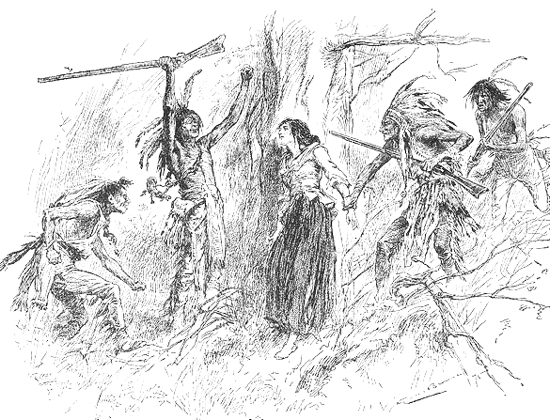
Laura Secord Discovered by British-Amerindian Allies. Image taken from Canadian Military Heritage Gateway website
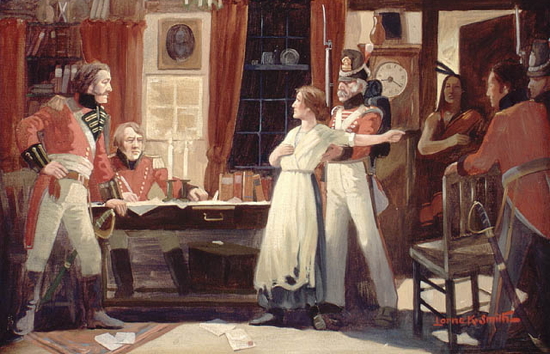
Meeting Between Laura Secord and Lieut. Fitzgibbon, June 1813. Rencontre entre Laura Secord et le lieutenant Fitzgibbon, juin 1813. LAC 1997-229-2, Lorne K. Smith, ca. 1920
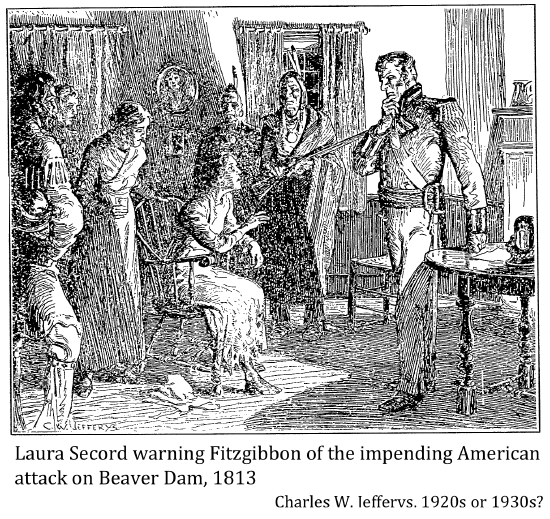
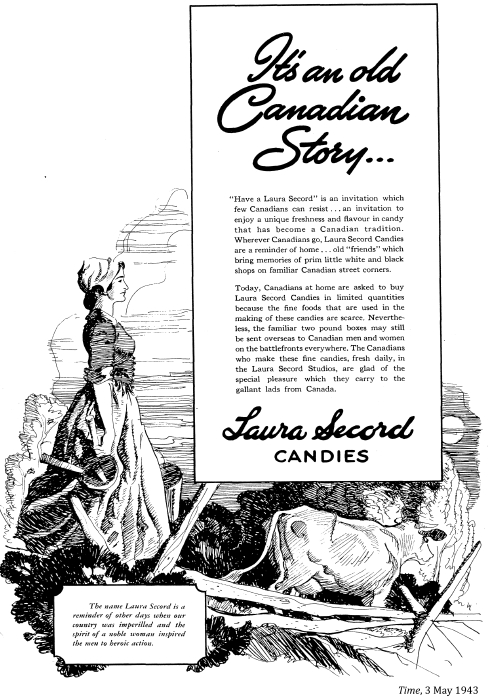
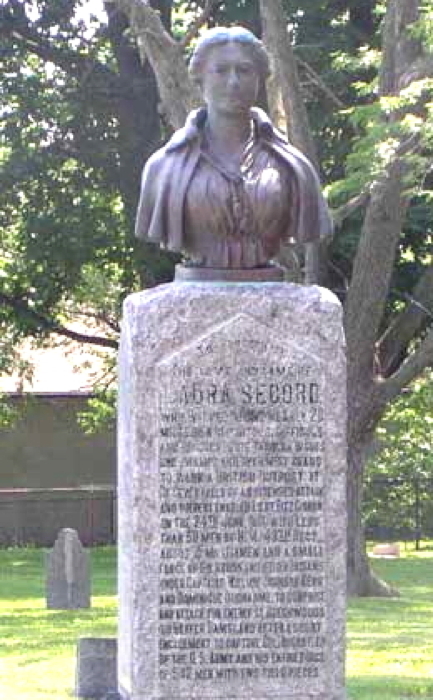

Perry's Victory. LAC Acc. No. 1970-188-1538 W.H. Coverdale Collection of Canadiana, ca. 1900 [Oliver Hazard Perry is remembered for the words on his battle flag, "Don't Give Up the Ship" and his message to General William Henry Harrison which reads in part, "We have met the enemy and they are ours; ..."]
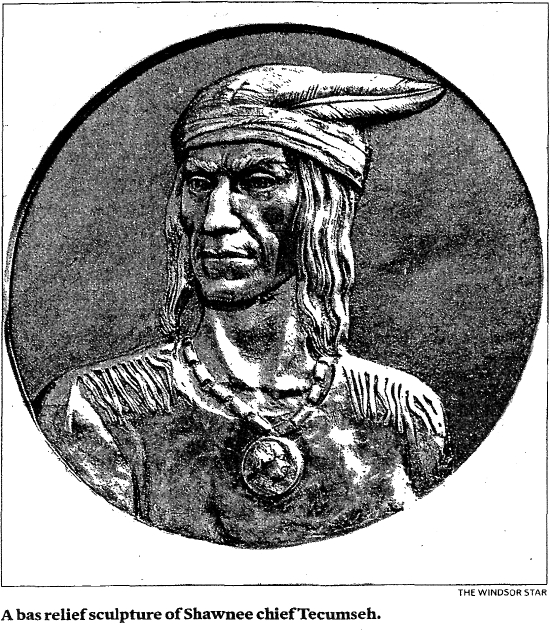
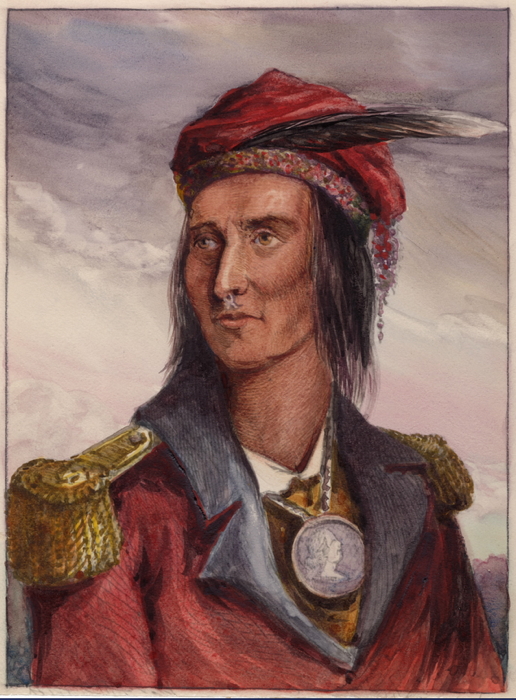
Tecumseh, John Benson Lossing, Toronto Reference Library JRR 3358 Cab. 1863
Portrait of Tecumseh, Benson John Lossing, Toronto Reference Library JRR 3358 Cab, 1863
[Lossing writes, in notes on pp. 189 & 283, that LeDru was a young French trader whose pencil sketch, c. 1808, was in the possession of his son at Quebec in 1848 when Lossing copied it. The head only is after Le Dru: "The cap was red, the band ornamented with colored porcupines' quills, and in front was a single eagle's feather, black, with a white tip." The uniform and medal are after a rough drawing Lossing saw in Montreal in 1858, made by an unknown artist in 1812 at Amherstburg. The drawing "did not pretend to give a true likeness of the chief, and was valuable only as a delineation of his costume." The wood engraving first appeared in Lossing's "Scenes in the War of 1812" in Harper's New Monthly Magazine, New York, May 1863, p. 733.
Water colour attributed to Owen Staples and with mat window opening indicated by pencil border, of wood engaving in Lossing's The Pictoria Field-Book of the War of 1812, New York, Harper & Brothers, 1868, p. 283 (probably the impression in Toronto Public Library's copy 2) Laid down on light olive grey card board.]
"Without the War of 1812, aboriginal Canadians would have suffered the same fate as American Indians."
James Moore, Globe and Mail, 10 March 2012
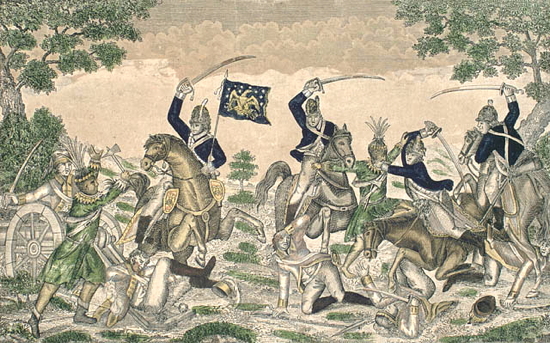
Col. Johnson's Mounted Men charging a party of British Artillerists and Indians at the Battle fought near Moraviantown October 2nd 1813. Les hommes du colonel Johnson, à cheval, attaquant un groupe d'artilleurs britanniques et d'Indiens pendant la bataille qui a eu lieu près de Moraviantown, le 2 octobre 1813. LAC C-007763, 1813
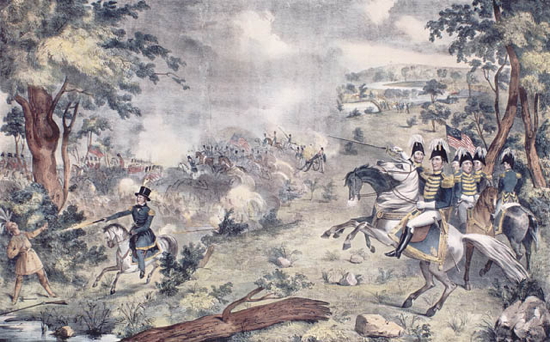
Battle of the Thames, October 5th, 1813. Bataille de la Thames, 5 octobre 1813. LAC Acc. No. 1970-188-2005 Collection de Canadiana W.H. Coverdale, Philadelphia 1840
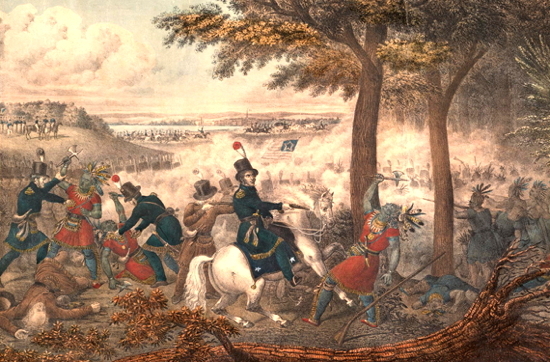
Battle of the Thames, (Oct. 5, 1813). La bataille de Thames, 5 octobre 1813. LAC 1970-188-997 Collection de Canadiana W.H. Coverdale, William Emmons, 1833
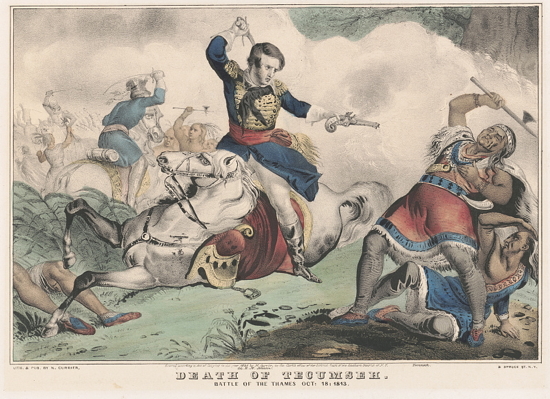
Death of Tecumseh, Battle of the Thames 18 Oct. 1813, 1846, LC91794824

The Dying Tecumseh, National Portrait Gallery, Frederick Pettrich, 1858
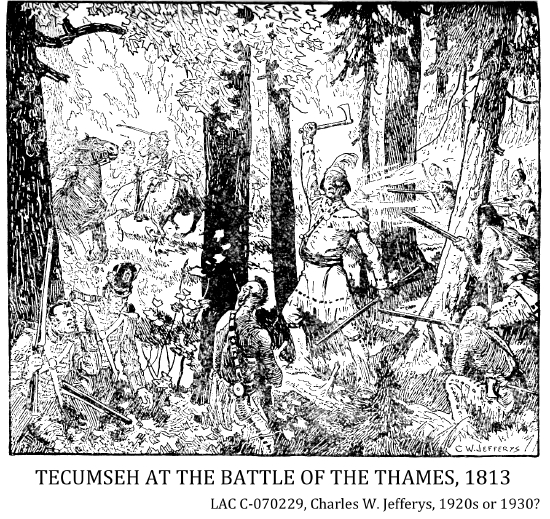
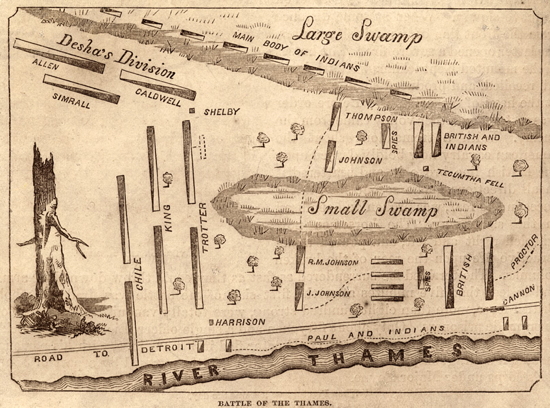
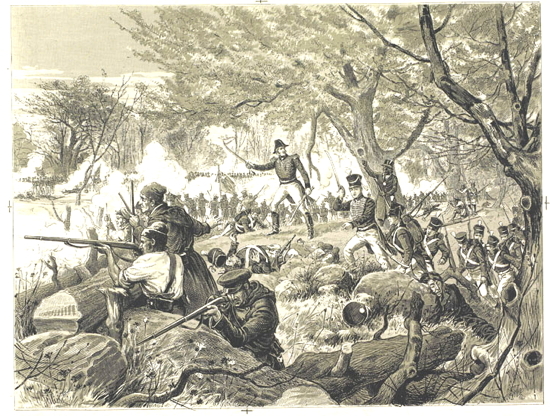
Bataille de Chateauguay, 1813. LAC Acc. No. 1984-164-46 Source: Mr. Laurent Allard, Laval, Québec. Henri Julien, 1880-1908
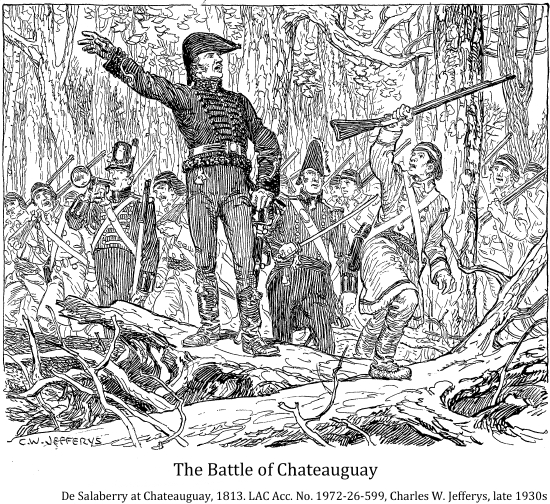
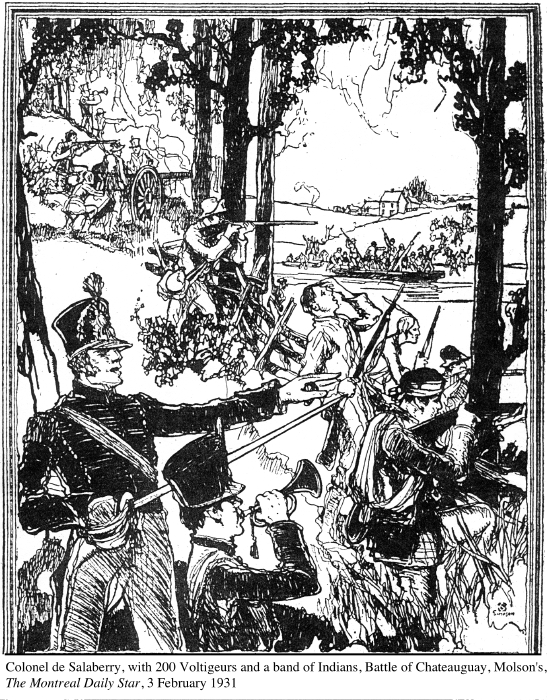
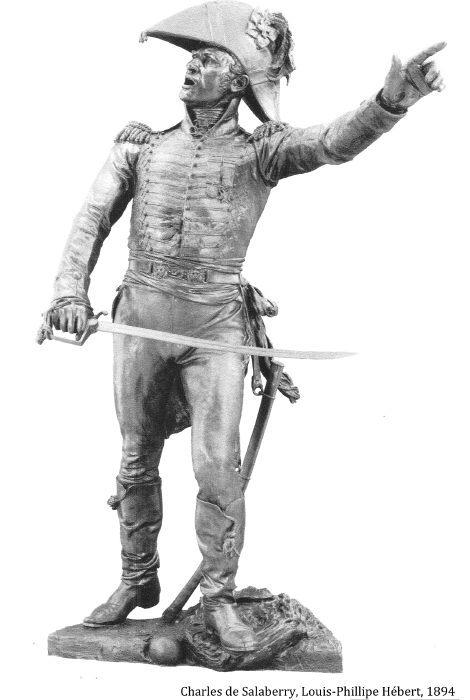
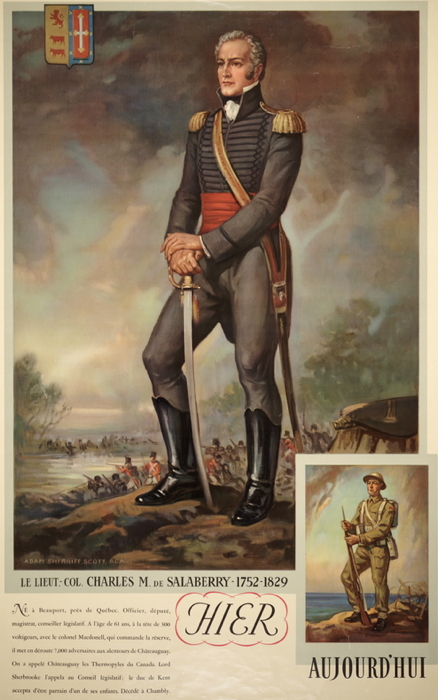
Le Lieut.-Col. Charles M. de Salaberry, 1752-1829- hier, aujourd'hui, TRL 1939-45. Historical pictures. Item 3 Battle of the Thames, The story of the greatest nations, 2 October 1913, Public domain, via Wikipedia Commons
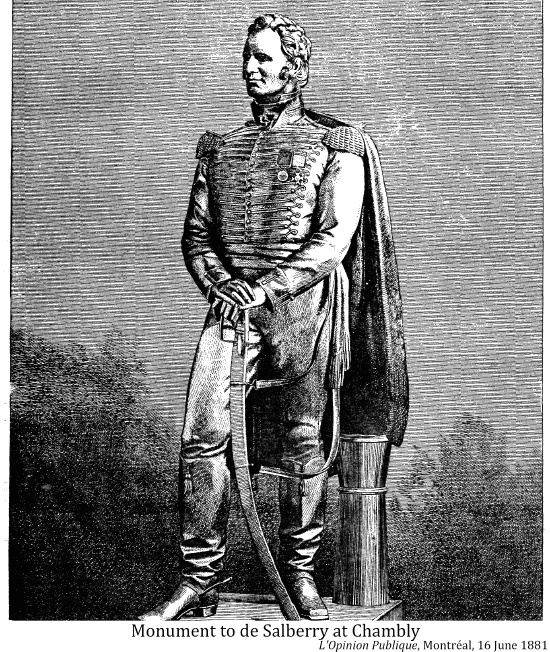
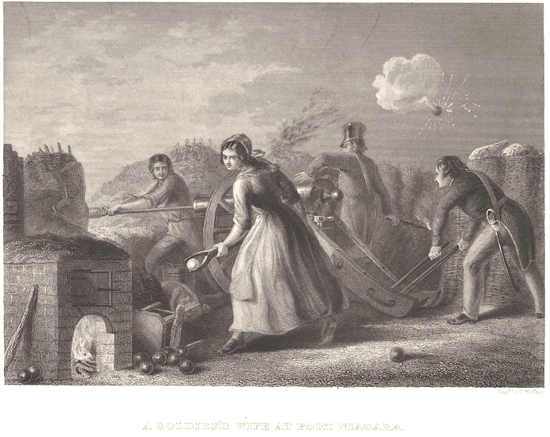
A Soldiers Wife at Fort Niagara. La femme d'un soldat a` Fort Niagara, by T. Walker, Dec. 1813, LAC e010952214
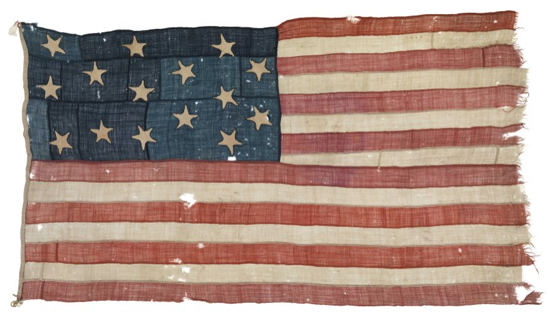
USA merchant ensign from a merchant brig captured by HMS Borer, Captain Richard Coote during the War of 1812, between 1813 and 1814, National Maritime Museum, Greenwich, London, Public domain, via Wikimedia Commons
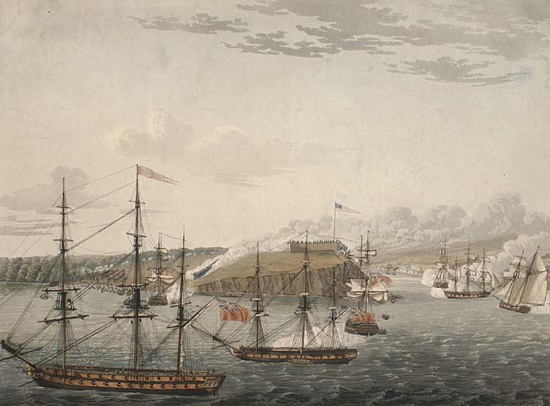
Attack on Fort Oswego, Lake Ontario, N. America. May 6th, 1814, Noon. Attaque contre le fort Oswego, lac Ontario, Amérique du Nord, le 6 mai 1814, à midi. LAC c000794k, John Hewett, 1815
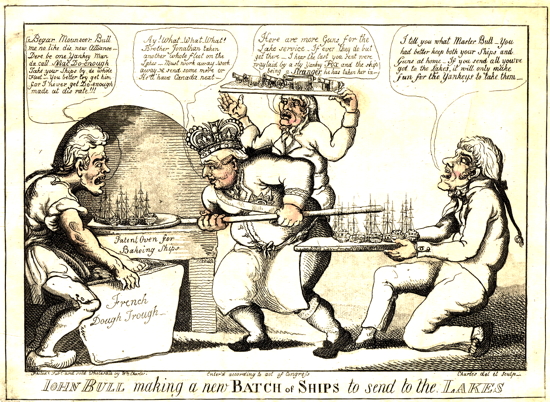
Batch of Ships, Toronto Reference Library, 958-6 Cab II, 1814
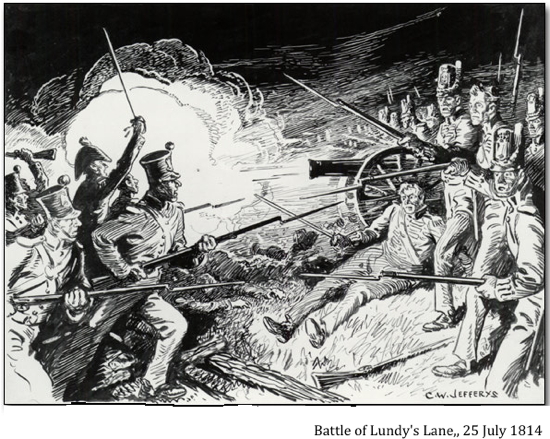
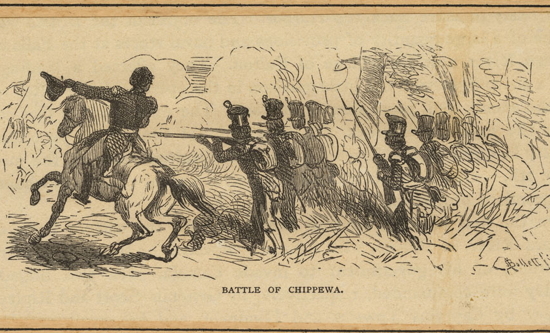
Bataille de Chippewa [5 juillet 1814] LAC Acc. No. 1958-46-2, Alfred Sandham, 1900?
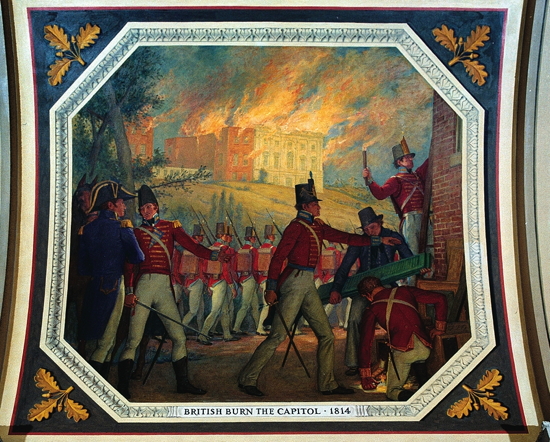
British Burn Capital, Alyn Cox, mural
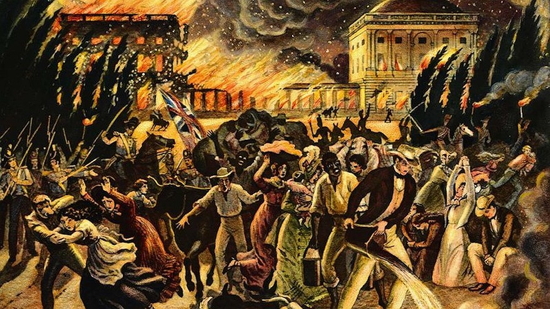
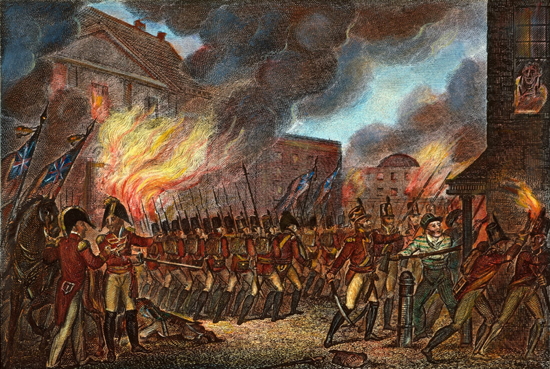
published London 1815

Map of Lundy's Lane Battle Grounds, 25 July 1814, Time 9 p. m. LAC C-093560, Alfred Sandham, ca. 1900
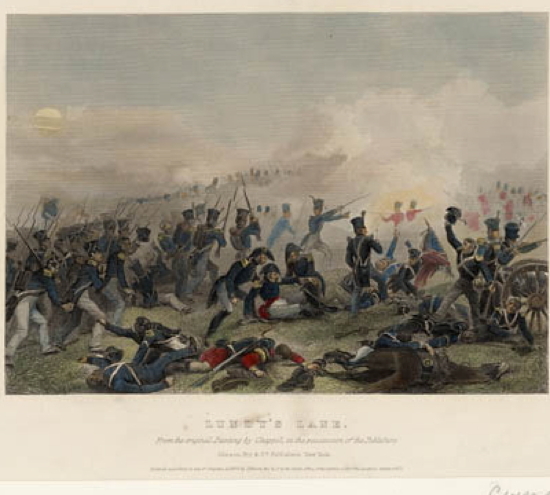
Lundy's Lane. LAC Acc. No. R9266-3304, Alonzo Chappel, 1859
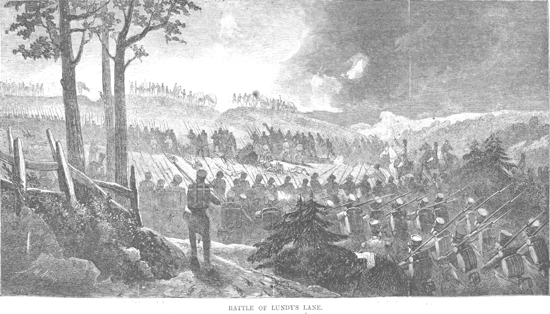
Battle of Lundy's Lane, 25 July 1814, Harper's Weekly, New York, 16 June 1866
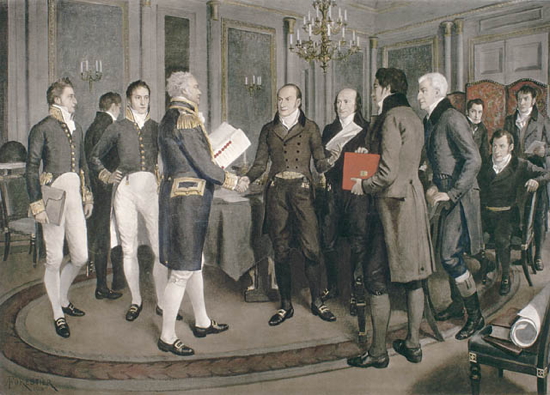
A Hundred Years Peace. Cent ans de paix. LAC Acc. No. 1993-275-1, Amedee Forestier, 1914 [The Signature of the Treaty of Ghent between Great Britain and the United States of America, Dec. 24th, 1814]
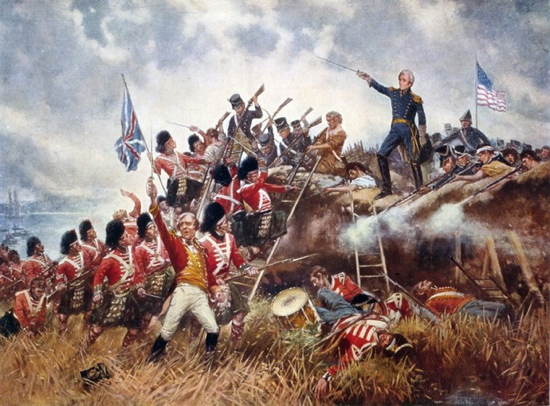
The Battle of New Orleans, E. Percy Moran, 8 January 1815, LCCN92510337, Miscellaneous Items in High Demand, PPOC, Library of Congress, Public domain, via Wikimedia Commons
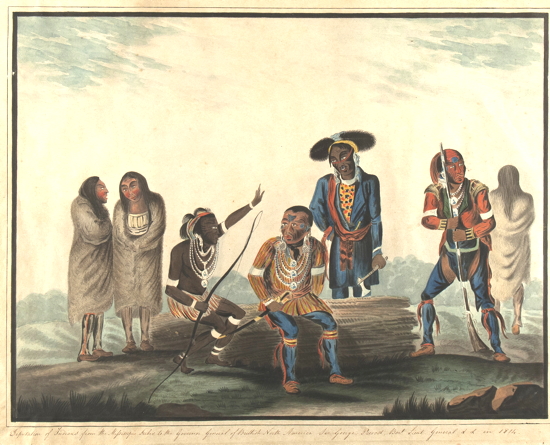
Deputation of Indians from the Mississippi Tribes to the Governor General of British North America, Sir George Prevost in 1814, by Rudolf Von Steiger, Public domain, via Wikimedia Commons
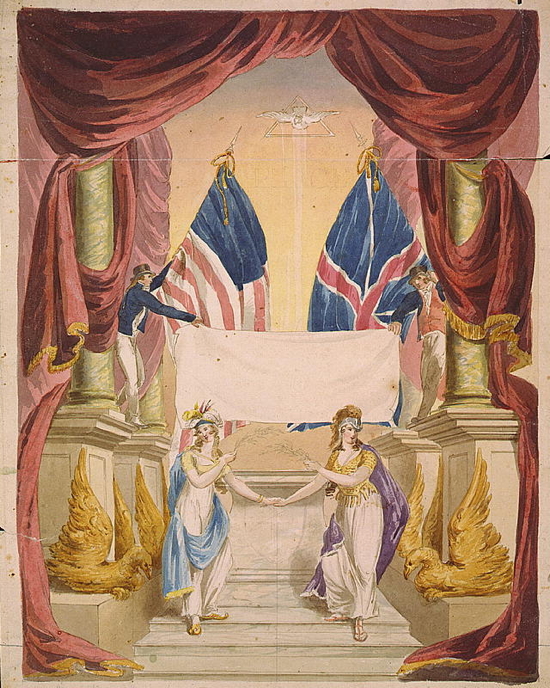
Peace, by John Rubens Smith, 1814, Public domain, via Wikimedia Commons, LCCN95509666
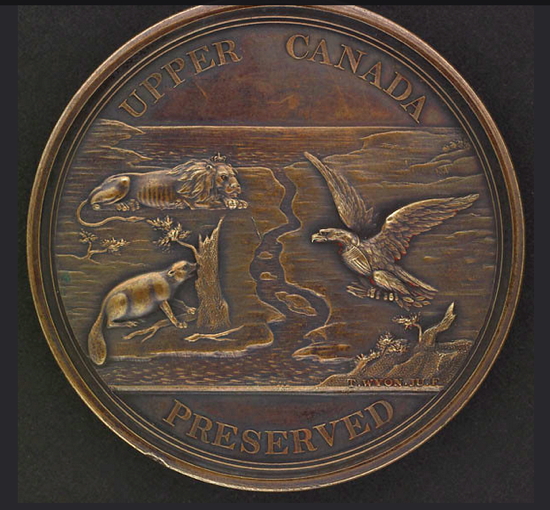
Medallic object. Thomas Wyon, LAC Acc. No. 1986-79-1328, ca. 1812
"Remembering is always going to be selective and partial, particularly when it comes to war . . . We see the War of 1812 we want to see, and overlook parts that don't confirm."
Globe and Mail, 10 March 2012
"[The War of 1812] the war that Canada won, or to put it more precisely did not lose."
Pierre Berton
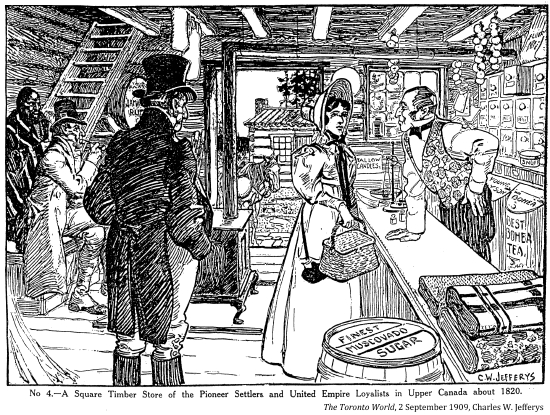
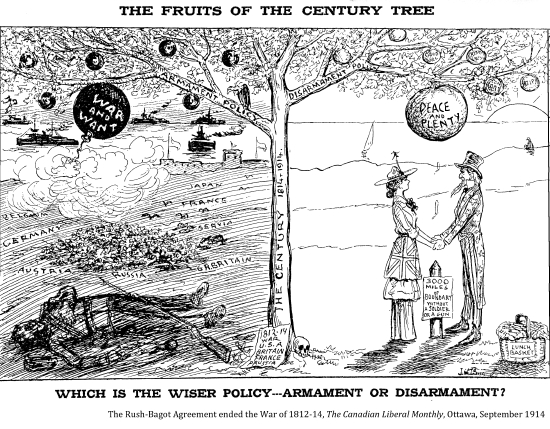
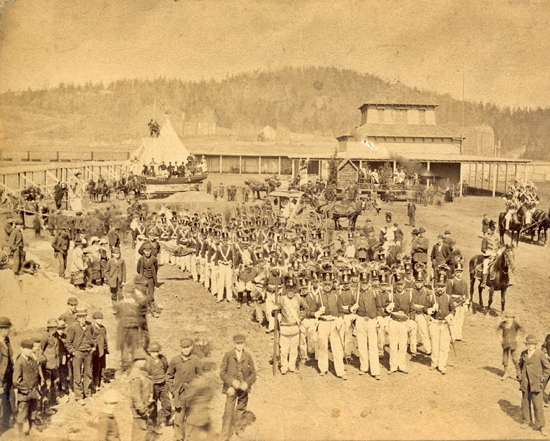
Gathering for the Parade, Loyalist Centennial, Saint John, New Brunswick, 1883, public domain via Wikimedia Commons
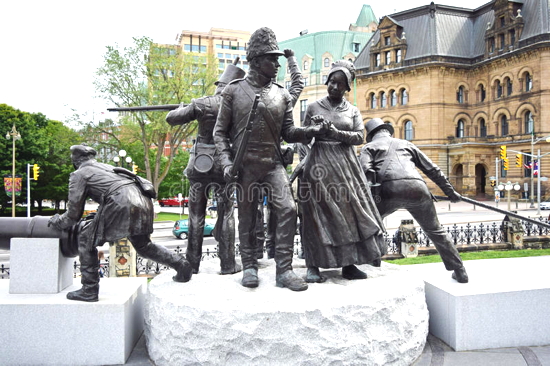
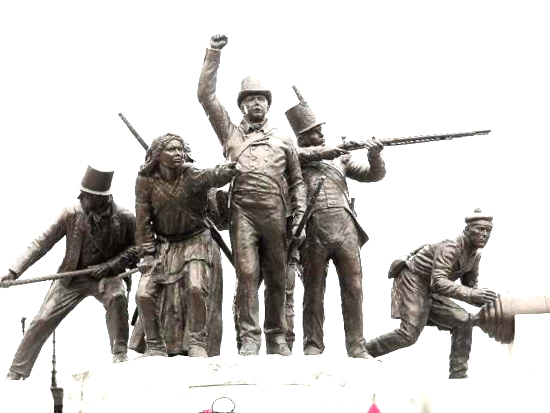
Triumph Through Diversity. This monument commemorates the 200th anniversary of the War of 1812. Ottawa, Adrienne Alison, 2014. The monument shows a Métis fighter firing a cannon, a woman bandaging the arm of a Voltigeur—a French combatant, a Royal Navy sailor pulling a rope, a First Nations warrior pointing into the distance, a Canadian militiaman raising his arm in triumph, and a member of the British Army's Royal Newfoundland Regiment firing a musket.
|























































































